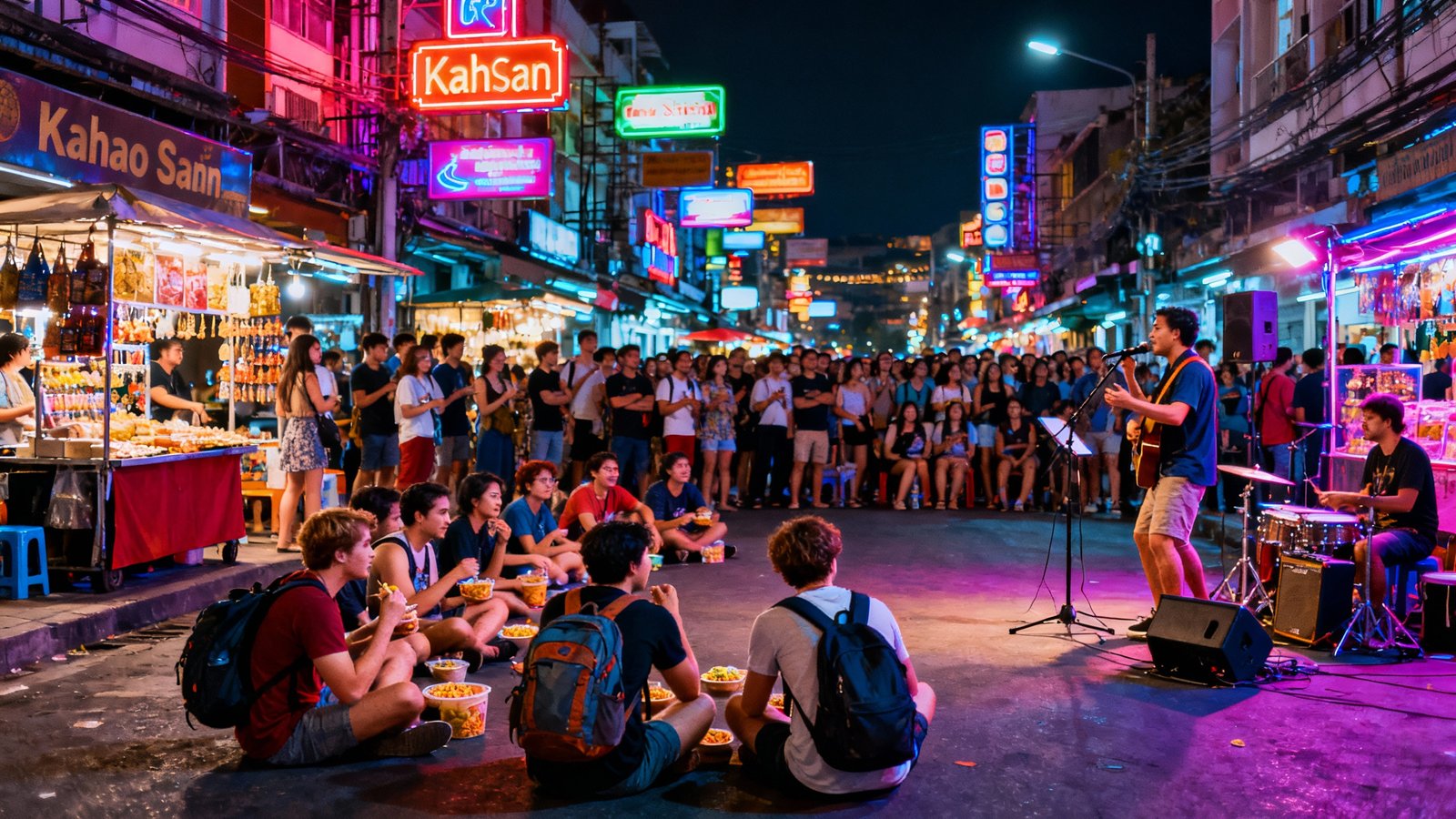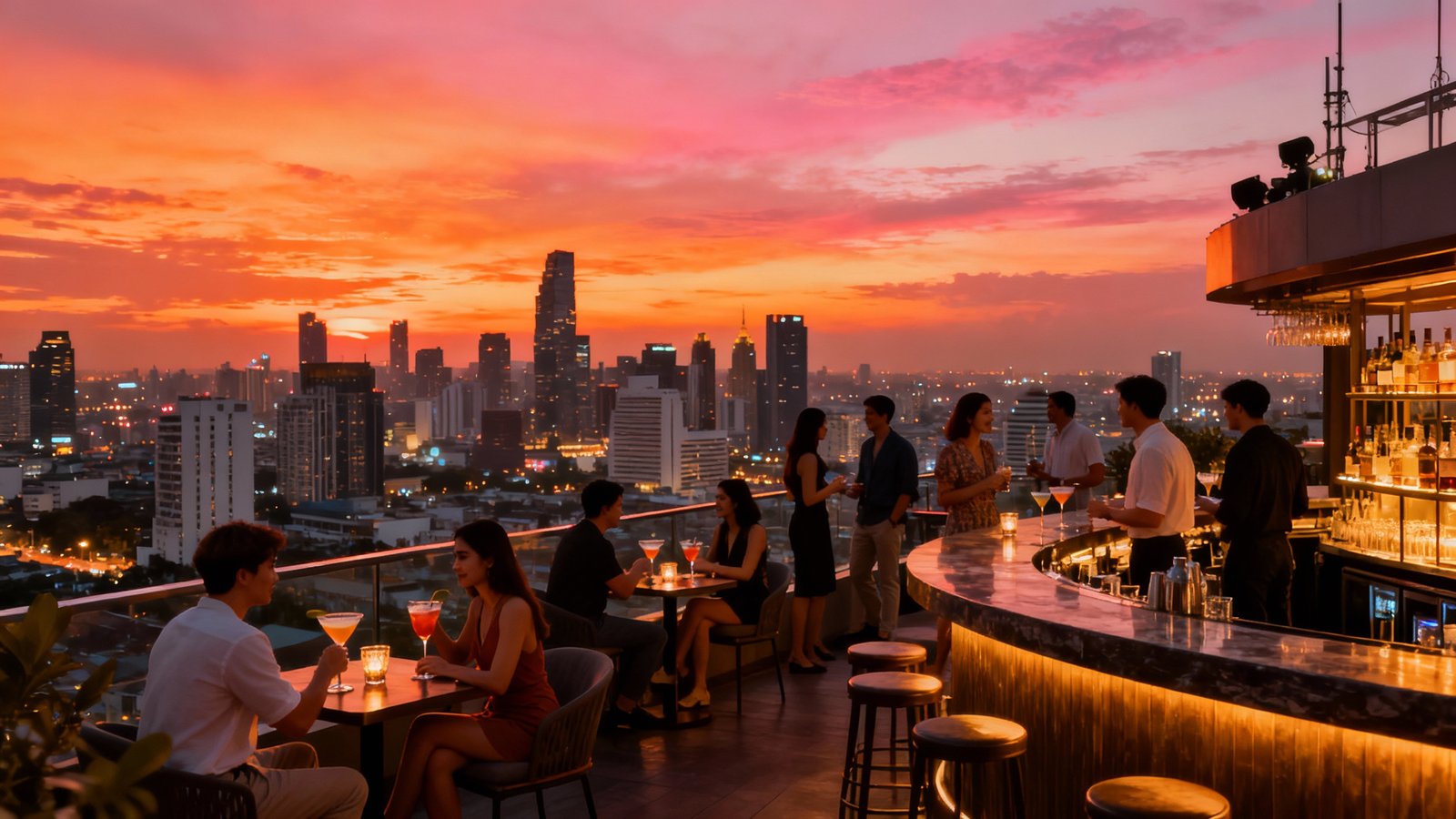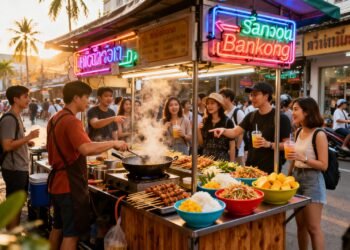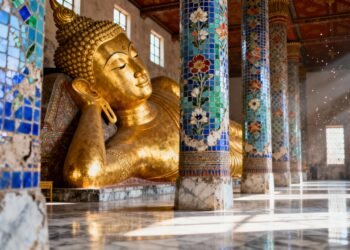Key Takeaways
- Insider’s guide to Bangkok’s must-visit temples, markets, and neighborhoods.
- Practical tips for first-time visitors: when to go, how to get around, and what to eat.
- Suggested itineraries to help maximize your stay, from dawn ‘til party hour.
- How to experience Bangkok food culture, nightlife, and hidden gems off the tourist trail.
- Resources for flights, hotels, tours, and booking essentials for a seamless trip.
 Introduction
Introduction
Bangkok is a city that seduces, energizes, and confounds in equal measure. Rising in tropical heat from the banks of the Chao Phraya River, Thailand’s capital pulses with infinite contradictions: ornate golden temples against soaring steel towers, monks gliding through chaotic markets, rooftop champagne bars looking out over gritty old neighborhoods. Here, street food stalls sizzle alongside world-class restaurants, and the city’s legendary nightlife blossoms every evening.
Born and raised in the heart of Bangkok, I invite you to peel back the layers of my city—whether you crave temple serenity, neon-soaked night markets, or sunrises by the river. This comprehensive guide is crafted just for you, bringing local insights, practical steps, and that magical feeling of stepping into the unknown. Welcome to Bangkok, where every day is an adventure.
Planning Your Bangkok Trip
Timing is everything in Bangkok. While the city is vibrant year-round, it’s at its finest between November and February, when the air is cooler and rain is rare. This is also high season, so expect bustling sights and higher accommodation prices. March through May brings intense heat—locals call it ‘hot season’—while June to October can mean short, heavy rains that clear up quickly, providing a greener city and fewer crowds.
Organize your stay between 3 and 5 days to capture the essence of the city: enough time for temples, canals, and endless street food. Keep in mind local holidays like Songkran (Thai New Year) in April, when festivities transform the city with water fights and celebrations. Plan ahead for accommodation, and consider staying in historic Rattanakosin, energetic Silom, or chic Sukhumvit, each offering a unique slice of Bangkok life.
Getting to Bangkok
Bangkok is a major Asian hub, making flying in a breeze. Most international travelers arrive at Suvarnabhumi International Airport (BKK) with its world-leading facilities and excellent connections. Nearby Don Mueang Airport (DMK) mainly handles regional and low-cost flights. Both are linked by public transport, taxis, and airport buses—helping you get into the city center quickly.
To find the best deals and convenient options, book your flights seamlessly through top comparison sites—you’ll often score lower prices and flexible dates. Once you’ve landed, hop on the Airport Rail Link for swift journeys to central Bangkok, or grab a taxi for door-to-door convenience, especially if you’re carrying luggage.
Navigating the City
Bangkok’s size can seem intimidating, but moving about is part of the city’s adventure! The BTS Skytrain zips above traffic, connecting shopping, nightlife, and key attractions in comfort and air-conditioning. The MRT subway complements the BTS, especially for Chinatown and Chatuchak Market. Ticket kiosks and English signage make both systems easy for newcomers.
Iconic tuk-tuks offer a quintessential—and often exhilarating—way to dart through winding alleys, though be sure to agree on a fare beforehand. Chao Phraya Express boats are the most picturesque means to reach riverside temples such as Wat Arun and local markets. For venturing outside the city or on day trips, renting a car is hassle-free and gives you total freedom, with pick-up locations at both airports and in-town.
The Grand Palace & Wat Phra Kaew
No visit to Bangkok is complete without marveling at the Grand Palace, a glittering symbol of Thailand’s rich heritage. Established in 1782, this sprawling compound was once the royal residence, and its intricate halls and golden chedis still dazzle locals and tourists alike. Within its grounds lies Wat Phra Kaew, home to the revered Emerald Buddha—a spiritual icon meticulously carved from jade.
Dress modestly: shoulders and knees must be covered. Plan for crowds and arrive early to watch the palace shimmer in the morning light. Explore the murals recounting Thailand’s epics and the ceremonial halls that have shaped the nation’s monarchy. For hours, ticket details, and guided tour information, the Grand Palace’s official website offers up-to-date information.

Wat Pho & the Reclining Buddha
Just a short stroll from the Grand Palace, Wat Pho is celebrated for its majestic Reclining Buddha: 46 meters long, glowing in gold leaf, with mother-of-pearl inlays on its feet. It’s not only the oldest, but also a revered birthplace of traditional Thai massage—don’t miss a blissful treatment at the onsite school.
Wander through quiet courtyards adorned with stupas, blooming frangipanis, and tinkling temple bells. Arrive early to enjoy the serenity, or time your visit for late afternoon light. For more visitor insights, check out Wat Pho’s Tripadvisor page.
Wat Arun (Temple of the Dawn)
Poised on the river’s west bank, Wat Arun’s porcelain-spangled towers rise like an ornate fortress against the sky. The temple is breathtaking at any hour, but sunset turns its pagodas into glowing lighthouses over the Chao Phraya.
Cross the river by ferry from Tha Tien pier for the best approach. Climb the steep steps for an unforgettable panorama of old Bangkok and the Central Business District. Guided tours can reveal the stories carved in every stucco figure. For reviews and photos, browse Wat Arun.
Floating Markets & Canal Life
Bangkok’s romance truly unfolds along its waterways. The most famous floating market, Damnoen Saduak, is an hour outside the city—a riot of wooden boats stacked with fruit, snacks, and souvenirs. Amphawa Market, open on weekends, offers a more local vibe with seafood grills and riverside cafés lit by lanterns after dusk.
Go early for the best photos and fewer crowds—most tours include pickup and a canal cruise. Try steaming coconut pancakes or sample fresh mango from a smiling vendor. For more details and to book a visit, explore the Amphawa Floating Market.

Chatuchak Weekend Market
Shopping enthusiasts and treasure hunters flock to Chatuchak Weekend Market, a labyrinthine bazaar boasting over 8,000 stalls. Open Saturdays and Sundays, it’s the ultimate place to find handmade crafts, vintage clothes, ceramics, antiques, home décor, and every Thai snack imaginable.
Bring cash, sunscreen, and an appetite for adventure: each zone has its own flavor, from hip clothing boutiques to local art collectives. For floor plans, stall guides, and opening hours, visit the official Chatuchak Market website.
Khao San Road
A rite of passage for backpackers, Khao San Road morphs every night into a neon-blazed festival of music, cheap beer towers, fried scorpions, and global camaraderie. The street’s energy is infectious: DJs, henna artists, massage parlors, and food carts test your senses from dusk until sunrise.
For a change of scene, duck into adjoining Rambuttri Road for laid-back bars and bohemian cafés. Khao San is also a springboard for tours and day trips, with dozens of travel agencies nearby.

Chinatown (Yaowarat)
After dark, Yaowarat’s golden dragon gates beckon you into a world of sizzling woks and ancient temple spires. This is one of the best places in Bangkok to feast on street food: crispy pork, dim sum, mango sticky rice, or sweet Chinese herbal drinks.
Don’t miss Wat Traimit with its astonishing solid-gold Buddha, and explore narrow alleys filled with gold shops and herbal pharmacies. Curious about current events, opening times, or suggested food walks? Yaowarat on Tripadvisor has all the latest tips.
Rooftop Bars & City Views
Bangkok shines after sunset from lofty perches. Bars like Sky Bar (at Lebua State Tower) and Vertigo (at Banyan Tree) offer dazzling city panoramas, inventive cocktails, and an unmissable escape from street-level chaos. Dress codes apply: think smart casual, and arrive early to snag the best views without the crowds.
For insiders’ favorites and reservations, check out Sky Bar’s official site.

Thai Food & Culinary Highlights
Bangkok is an eater’s paradise. Begin with classic street-side pad thai or khao gai tod (fried chicken rice), then plunge into steamy night markets for grilled seafood, spicy som tam salad, and tropical fruit shakes. Don’t leave town without mango sticky rice—ideally from a stall with a long local queue.
Every neighborhood has beloved food courts and hidden gems. Silom is home to some of the best noodle shops, while Sukhumvit is a playground for modern Thai bistros. When choosing a place to stay close to food hubs, compare top Bangkok hotel deals and locations for a convenient base.
Best Food Tours & Cooking Classes
To take your culinary exploration beyond the basics, join a guided street food tour or Thai cooking class. Expert guides help you navigate night markets, teach you the art of balancing flavors, and introduce you to dishes only locals know about.
Consider booking a Bangkok food tour or cooking class for an immersive experience, complete with tasty memories and new cooking skills to bring home.
Hidden Gems in Bangkok
While major attractions dazzle, Bangkok’s soul thrives in its quieter corners. Explore Talad Noi for colorful graffiti, mechanic shops, and riverside coffee hideouts. Meander through Bang Krachao, the city’s green lung, where cycling paths wind through lush tropical gardens.
Seek serenity at Wat Prayoon with its turtle pond, or discover Papaya Vintage, a quirky museum brimming with retro Thai memorabilia. In neighborhoods like Ari, indie cafés, jazz bars, and local markets offer a slice of everyday Thai life well beyond the tourist map.
Day Trips from Bangkok
Venture beyond the city for a taste of Thailand’s ancient roots. Ayutthaya, a UNESCO-listed former capital, lays out atmospheric ruins and enchanted temples just an hour’s journey from the city. The Maeklong Railway Market astounds when trains roll straight through narrow market stalls, while Amphawa offers firefly-lit evening boat rides.
For planning a day trip and updated schedules, visit the official Ayutthaya Tourism page.

Practical Tips for Visitors
Bangkok is friendly, but certain customs matter. Dress modestly when visiting temples (cover shoulders and knees), and always greet monks with respect. A gentle wai (palms pressed together) is a polite greeting. Avoid touching people’s heads and never point your feet at anyone or religious icons.
Bargaining is expected at markets, but do so with a smile. Street scams are rare but stay mindful around main tourist sites. For exchanging currency, use trusted online platforms for the best rates and secure transactions. Carry small bills for convenience, and watch your belongings in crowded areas.
Travel Insurance & Booking Essentials
Travel insurance is a must for Bangkok—for health emergencies, luggage mishaps, or missed bookings. Choose a comprehensive policy tailored for Thailand travel so you can relax and enjoy every moment. Most popular attractions, markets, and shows sell out in advance; booking tours through reputable agencies gives peace of mind and priority access.
Consider locking in special-experience tours for floating markets, cooking classes, or cultural performances to round out your trip.
Sample Itinerary: 3 to 5 Days in Bangkok
Day 1: Arrive and settle in, then visit the Grand Palace and Wat Phra Kaew in the morning. Cross to Wat Pho for the Reclining Buddha, then stroll the riverside or hop on a boat tour. Finish with sunset drinks at a rooftop bar.
Day 2: Immerse yourself in Thai street food and market life at Chatuchak (if it’s the weekend), then explore Chinatown for lunch and temples. After a rest, plunge into the nightlife of Khao San Road.
Day 3: Take a guided tour to Damnoen Saduak Floating Market or book a day trip to Ayutthaya. Return to town for a Thai massage and dinner along Sukhumvit.
Day 4 (Optional): Cycle in Bang Krachao or discover hidden alleys in Talad Noi and Ari. Wind down with a hands-on cooking class or an evening food tour for local bites you may have missed.
Day 5 (Optional): Wrap up your trip with spa time, last-minute market shopping, or a visit to the Maeklong Railway Market before catching your flight home.
Conclusion
Bangkok isn’t just a destination—it’s a sensory spectacle, a cultural melting pot, and a gateway to the very soul of Thailand. From the dazzling spires of Wat Arun to the noisy exuberance of night markets, every corner will leave you with unforgettable memories and a hunger for more.
Whether you’re a first-time visitor or a returning traveler, there’s never been a better time to discover the city’s dynamic energy and endless charm. It’s all within reach—temples at dawn, cocktails at sunset, the tantalizing flavors of street food, and the warmth of Thai hospitality.
Ready to create your own Bangkok story? Find the smartest ways to plan and book every element of your journey with TripVista360’s innovative travel tools and make your dream trip a reality.
FAQs
1. What is the best time of year to visit Bangkok?
The cooler months from November to February offer the most comfortable weather and lively festivities.
2. Is Bangkok safe for solo travelers?
Yes, Bangkok is generally safe, but exercise regular travel precautions: use reputable taxis, watch your belongings in crowded areas, and avoid unlicensed vendors.
3. How do I get from the airport to the city center?
Airport Rail Link, taxis, airport shuttle buses, and car rentals are all available for convenient transportation to central Bangkok.
4. Can I drink tap water in Bangkok?
Tap water is not recommended for drinking. Stick to bottled or filtered water, readily available everywhere.
5. What should I wear when visiting temples?
Wear modest clothing that covers your shoulders and knees. Remove shoes before entering temple interiors.
6. Where can I find authentic Thai street food?
Explore areas like Chinatown, Silom, and Chatuchak Market for a vast range of local dishes and snacks from trusted vendors.
7. Should I book tours and tickets in advance?
For popular attractions or day trips, booking ahead is wise to avoid long waits and secure your preferred times.
8. Do I need a visa for Thailand?
Most nationalities receive visa-free entry for 30 days, but always check current requirements with the Thai embassy before traveling.



 Introduction
Introduction





